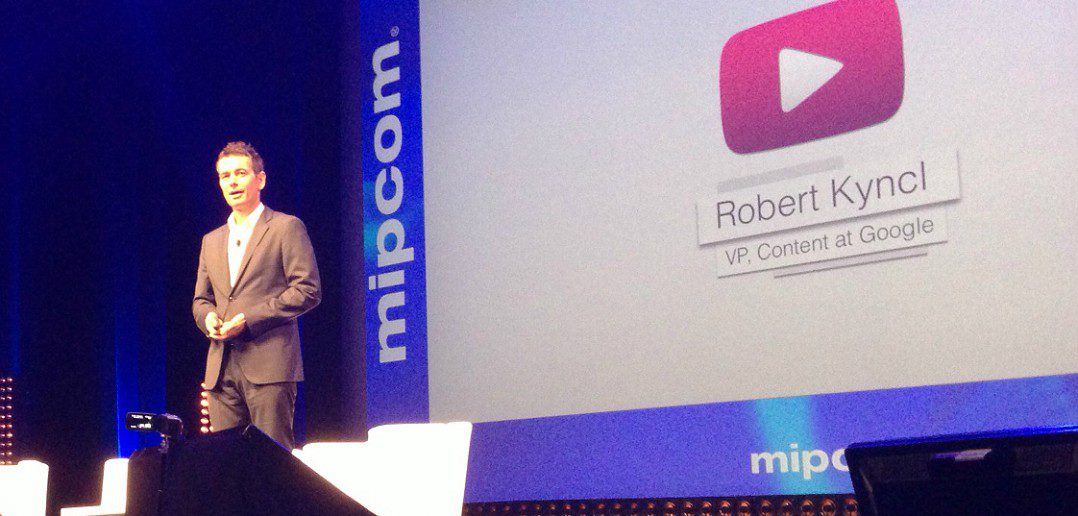Watch MIPCOM conference videos in full here
YouTube announced its big news earlier today: 60 new YouTube channels, 50 of them in Europe, with partners including All3Media, Zodiak Media Company, Jamie Oliver, BBC Worldwide and ITN, along with a number of brands that were built on YouTube itself.
VP and global head of content Robert Kyncl gave a Media Mastermind keynote at MIPCOM today to expand on YouTube’s strategy, including getting some of those key partners on-stage.
He started with a question: what’s the difference between content and distribution? Audience. « One has it, the other one wants it. »
He also noted that « the cost of owning an audience has gone up tremendously over the last 30 years, and because of that, it has been reserved for the well-heeled pockets of large media companies« . Until YouTube, which now has 800m people watching 4bn hours a month on the service.
Cue a Gangnam Style slide – PSY, the South Korean rapper who is topping charts worldwide on the back of more than 400m YouTube views. But Kyncl talked about other stars who’ve been created on the service, and the desire of consumers to watch them.
« Audiences are rapidly changing, and if you want to keep up with them, you have to programme on YouTube, » said Kyncl, who went on to point to the wave of investment going into companies making digital content.
« Whenever you see the consumers shift, investors sit up and pay attention, and they are surely paying attention to YouTube channels this year. » And Kyncl added that this was exactly what YouTube was hoping for when it launched its channel-funding initiative in 2011.
« None of this would be possible without revenue, » continued Kyncl. « We’re making ads optional. Users can skip them if they don’t like them. That’s a big deal. When advertisers pay only when ads are watched, and when viewers are watching only the ads that they care about, advertisers pay more. And they don’t mind. That means that content creators are making more. Everybody wins… Our system is starting to work. »
In the US, when YouTube compares its skippable video ads, « we are making as much revenue per hour as ads on cable TV« .
What does this mean for the MIPCOM audience of broadcasters and producers? « You need to be in the audience business… It pays. »
After this prepared speech, the session moved into a panel discussion focused on media, advertising and investment. Kyncl was joined by Peter Tortorici, CEO of GroupM Entertainment; Yair Landau, partner at MK Capital; and Alex Mahon, CEO at Shine Group.
The discussion kicked off with that question of what’s more valuable today: content or distribution? « Neither is valuable without the other, but more important than both is marketing, » said Landau. « In the marketing area is where you get the biggest gap between Silicon Valley and Hollywood. »
Tortorici agreed that the two concepts are « so completely interdependent… it’s the interdependent relationship with both that ultimately drives the business. »
Mahon was asked about the role YouTube plays in creating value around TV content. She said that over the last 10 years, distribution has become more commoditised, but that what YouTube allows producers to do is to connect with their audiences.
Kyncl chimed back in: « Distribution can be incredibly valuable, and today it doesn’t have to cost as much to get into that game, whether you do it with shortform original content, or if you do it with ancillary content that you already have… The point is today, thanks to YouTube, you can start building your audience and having that direct to consumer relationship. »
Landau was asked for his view as an investor on YouTube channels. « The really big shift it in the form of the content, » he said, focusing on the fact that 3-5 minute clips can be genuinely meaningful in the context of YouTube. Which is why startups are making the most of this, and why traditional TV companies arguably haven’t – that leap to prioritising shortform content is a big one for many of them.
Mahon gave the producer’s view, about always having been intermediated by a broadcaster, for better or worse. Now, for the first time, they can connect directly to viewers. « It may give us more power to connect directly with advertisers, » she said. « It may give talent more power as well. »
Tortorici gave the advertiser’s viewpoint. « We need to speak the language of both the producer, and the network, and the advertiser, and ultimately make that conversation productive, » he says.
He added that the media industry is used to « siloed competitive roles », yet the way the market is evolving demands constant reinvention and collaboration. « We’ve always got to be able to be really nimble about what our roles are, » he said.
Landau enthused about YouTube’s disintermediation role in the media industry. « YouTube represents what happened in the music space, what happened in the newspapers space, happening in the video space, » he said.
What’s the one YouTube channel that people would like to see that doesn’t exist yet. Kyncl would love a great skiing channel, while Mahon wants « crowdsourced citizen journalism ». Meanwhile, Landau said he’d like to see a lot more activity in the children’s entertainment sector – « a bona-fide kids section ».




